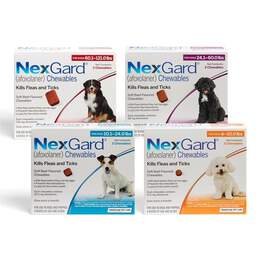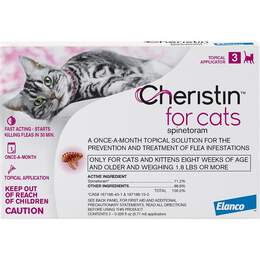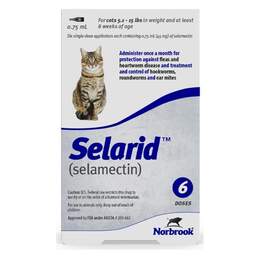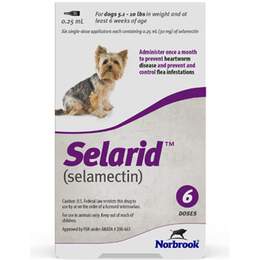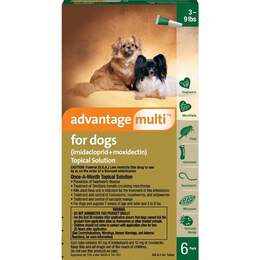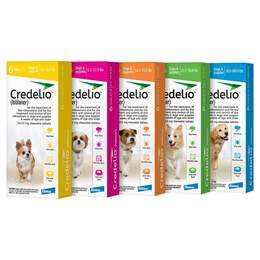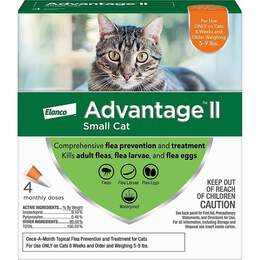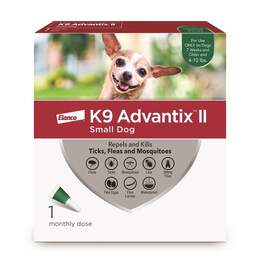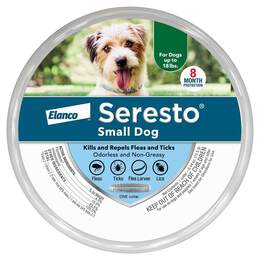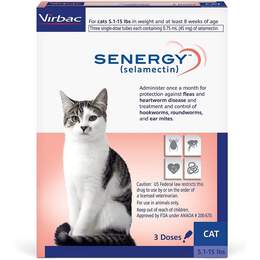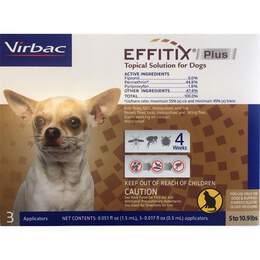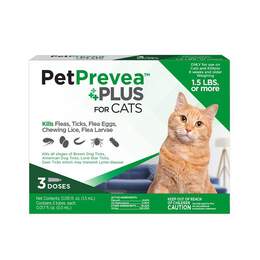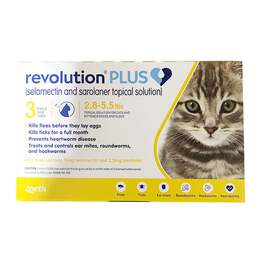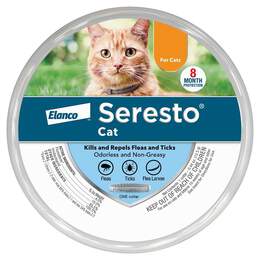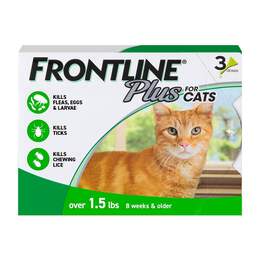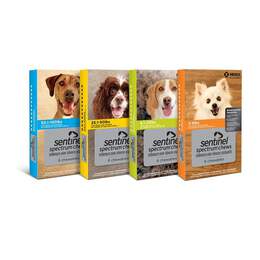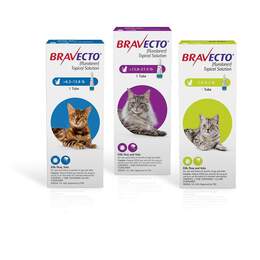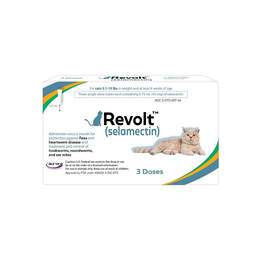Flea & Tick
Related Categories
A dog or cat incessantly scratching and biting at an itch irritates pets and pet parents alike. If your pet is allergic to flea bites, they can not only make them itchy and uncomfortable but cause flea allergy dermatitis, which can lead to hair loss and skin infections. Tick bites can carry diseases such as Lyme disease, and when they hitch a ride into your home, they can bring diseases with them.
For this and many other reasons, the last thing you want to happen is a flea or tick infestation in your home. Giving your pets flea and tick medicine regularly can protect your family, your pets, and your home from an infestation and the risks it can bring.
Types of Flea & Tick Prevention
There are many flea medicines as well as flea and tick options available for cats and dogs that can keep these irritating pests at bay. They can be applied at different regularity or in different ways. The type of flea and tick meds you choose depends on your pet's needs and, often, where you live. When deciding on the correct flea medicine for your cat, dog, or ferret speak with your veterinarian. They can guide you based on your pet's age, weight, medical history, and the prevalence of fleas and ticks in your area.
Spot-on Flea and Tick Treatments
Spot-on or topical flea and tick medicine is applied directly to your pet's skin, usually at the base of the neck or between the shoulder blades. These popular and convenient treatments repel fleas, ticks, and mosquitos. Once applied, they spread over your pet's entire body and into their sweat glands, allowing the active ingredient to be released over time. These treatments generally keep your pets safe from ticks and fleas for one month.
Oral Flea and Tick Treatments
Oral flea medications are usually chews, such as Nexgard, formulated to be tasty and easy to administer. Some of these products also help prevent heartworm disease and other internal parasites such as hookworms, roundworms, and whipworms.
Oral flea and tick meds have few side effects, but they may cause vomiting, depression, lack of appetite, and diarrhea, as well as skin reactions that cause redness, itching, irritation, or hives. If you notice these symptoms in your pet, contact your veterinarian right away.
Sprays, Powders, Shampoos, and Flea Collars
Sprays, powders, shampoos, and flea collars are relatively easy to use. When using sprays, shampoos, and powders, avoid getting the product close to or in your pet's mouth or eyes.
Powders are dusted over your pet's entire body and rubbed into the fur. Make sure you get it between the toes. Powders may have side effects such as vomiting, diarrhea, depression, drooling, shaking, and lack of appetite.
Shampoos wash away flea dirt, flea eggs, and adult fleas. They generally do not keep fleas from returning and will not stop an infestation. Follow all directions on the label.
Flea collars disperse a chemical to keep fleas and ticks off your pet. They provide some protection for your cat or dog for several months.
Is Flea and Tick Medicine Necessary?
Pets can easily pick up fleas on their daily walks, playing outdoors in the yard, or at dog parks. Even indoor cats can get fleas that come inside on your clothing, your dog if you have one, and visiting pets. And once they take up residence on your pet, they can easily and quickly infest your home. A female flea can lay as many as 2,000 eggs during her lifetime.
If you notice your dog or cat is continually scratching, this may be a sign that they have picked up fleas. You may see fleas on your pet, making the reason for their itchiness obvious.
But just because you don't see fleas doesn't mean they aren't there. If your pet is light-colored or doesn't have a lot of hair on their belly, check this area for tiny brown flecks. Scrape a few off with a paper towel and add a couple of drops of water. If they dissolve and the result looks reddish, your pet has fleas.
If you see bumps, rash, or hair loss around the base of your pet's tail, and an unpleasant smell, you are heading towards an infestation.
Understand the Dangers of Ticks
As soon as the weather warms, ticks become a menace for your pets. They lie in wait outdoors and grab a ride on the nearest warm body – probably your pet. Tick bites are painful and often cause a rash, swelling, and burning sensation. Even more concerning, tick saliva can transmit serious diseases such as Lyme disease or Rocky Mountain Spotted fever.
When a tick bites your pet, it injects a local anesthetic so that they won't feel the bite, so you may not know right away if your pet has picked up a tick. Then it sucks as much blood as it can from your pet. Ticks start out as small, about the size of the head of a pin, so they can be hard to find. As they feed, they become engorged, making them easier to see on your pet.
Ticks can be difficult to remove from your pet, so contact your veterinarian, who can tell you the best way to get the pests off of your pet. When infested with ticks, your dog can become anemic and, in some cases, paralyzed. If these ticks reproduce in your home, it can easily become infested with thousands of these pests.
Importance of Year-Round Flea and Tick Protection
No matter if you live in an area with distinct seasons or one where it is warmer almost the entire year, giving your pets flea and tick medication year-round is a good idea. Warm, heated homes can also be a breeding ground for fleas that enter your home. Even inside pets are vulnerable, since you, your family, and visitors to your home may bring these pests inside on their shoes or clothing.
Even if you see fleas and ticks on one pet in your household, you should administer flea medicine to all pets in the house to avoid an infestation and protect your pets, your family, and your health.
Easy Ways to Give Your Pet Flea Medication
Giving flea medicine to your dog is usually pretty easy. They tend to be more cooperative when you use a topical treatment, and flea and tick chews are formulated to be tasty so that dogs will readily eat them from your hand.
We all know that cats can be a little more difficult. Applying a monthly spot-on treatment takes perseverance, stamina, and willpower. The easiest way is to "scruff" your cat. Grab the loose skin on the back of their neck, as close to the ears as possible. This gives you more control of your cat, and leaves the appropriate area for the spot-on treatment easy to reach. It may be a two-person job, as one of you can scruff the cat, and the other can quickly apply the flea treatment.
Some cats will readily take a flea chew as a treat hidden in food. Others may not. If you need to administer a flea pill to your pet, begin by scruffing the cat, this tends to relax them and give you control over their movements. Gently tilt their head back, and apply gentle pressure using your thumb and forefinger on each side of their upper jaw. Your cat's jaw should open slightly. When this occurs, place your forefinger in the tip of the jaw, and with slight pressure, your cat's mouth will open.
Using your other hand, insert the pill. Aim for the back of your cat's tongue so they can't spit it out. Release your cat's head, gently hold their mouth shut, and stroke downwards on their throat to encourage them to swallow. Always provide your cat with water after giving them a pill and reward them with their favorite treat.



